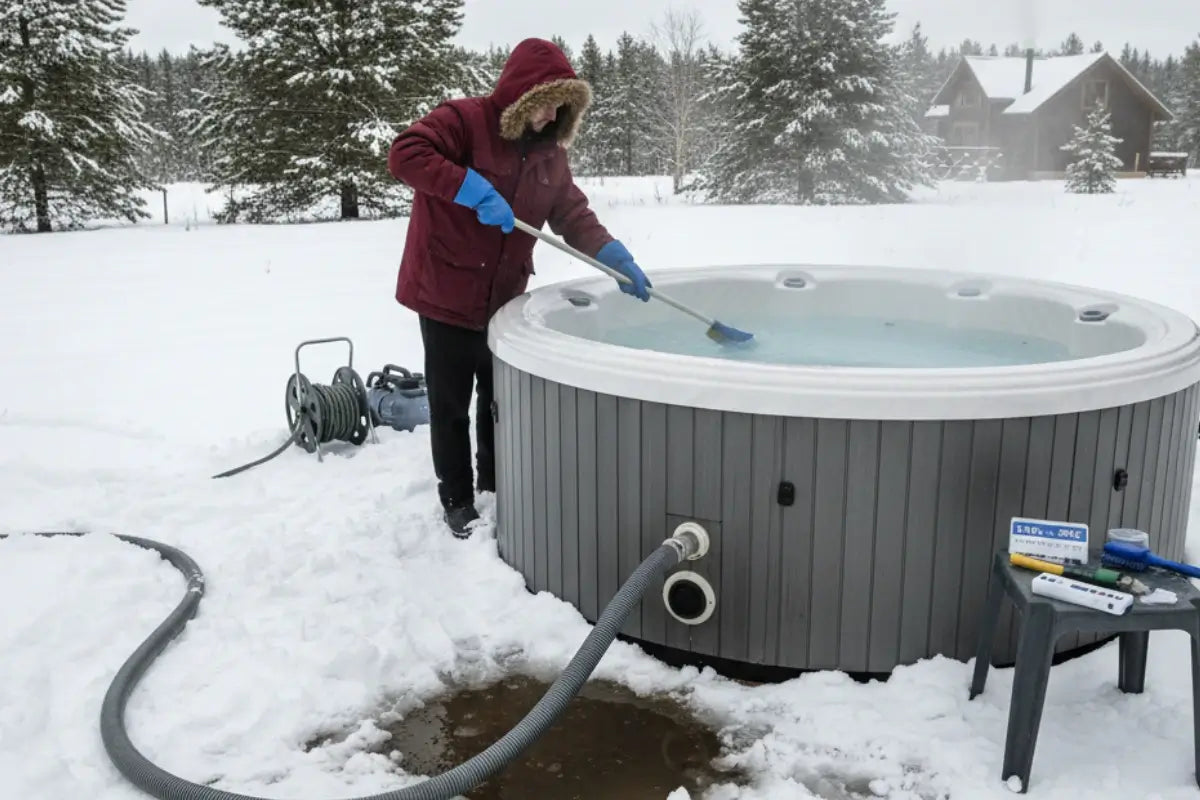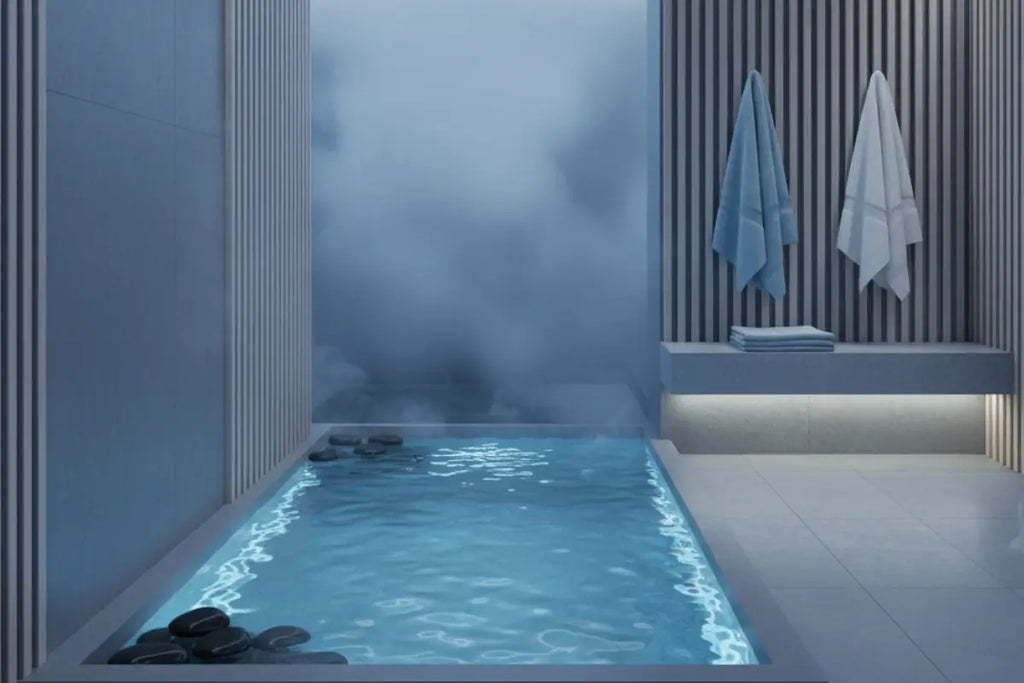7 Steps to Winterize a Hot Tub Properly

Winterizing your hot tub is more than a seasonal chore, it’s a smart investment in its longevity and your peace of mind.
Without proper preparation, freezing temperatures can cause costly damage to plumbing, pumps, and the tub shell. In this guide, we’ll walk you through 7 essential steps to protect your spa this winter.
Key Takeaways
Drain Thoroughly: Remove all water to prevent freezing and damage.
Clean & Protect: Scrub the shell and store filters indoors.
Clear Plumbing Lines: Blow out all water to avoid cracks and costly repairs.
Secure a Quality Cover: Keep snow, ice, and debris out of your hot tub.
Check Periodically: Inspect your hot tub during winter to maintain protection.
Do you need to winterize a hot tub?
Winterizing your hot tub is crucial to prevent freeze damage, which can crack plumbing, pumps, and heaters.
Neglecting this step may lead to repair costs ranging from $200 to over $1,500, depending on the extent of the damage.
Experts recommend winterizing every fall by draining all water, cleaning thoroughly, removing filters, blowing out plumbing lines, drying components, and securing with a quality cover.
This proactive maintenance ensures your hot tub remains intact and ready for use when temperatures rise.

7 Steps to Winterize a Hot Tub Properly
Drain All Water: Completely empty the hot tub to prevent freezing and cracking damage.
Clean the Shell: Scrub the interior surfaces to remove residue, dirt, and buildup.
Remove & Store Filters: Take out the filters, clean them thoroughly, and store them indoors to avoid damage.
Blow Out Plumbing Lines: Use a shop vac or blower to remove all hidden water from pipes and jets.
Wipe Everything Dry: Dry every surface, seat, and component to prevent mold and freezing.
Seal with a Quality Cover: Use a strong, well-fitted hot tub cover to keep out snow, ice, and debris.
Inspect Periodically: Check the hot tub occasionally during winter to ensure everything stays protected.
Why is Winterizing a Hot Tub Important?
Winterizing your hot tub isn’t just a seasonal chore, it’s essential to protecting your investment.
When temperatures drop below freezing, any leftover water in the pipes, jets, or pumps can freeze, expand, and cause serious damage.
This often leads to cracked plumbing, broken pumps or heaters, and even structural damage to the shell.
In severe cases, frozen water can also affect electrical components or warp the hot tub cover, creating safety hazards and costly repairs.
While there’s no set percentage of hot tubs that suffer damage, the risk is high if proper winterization is skipped, and repairs can easily range from a few hundred dollars for minor fixes to $2,000 or more for major plumbing or structural issues.
Experts recommend winterizing your hot tub every fall before freezing weather arrives. The process includes draining all water, adding hot tub-safe antifreeze, thoroughly cleaning, and securing the cover.
Taking these steps not only prevents expensive repairs but also ensures your hot tub will be ready to enjoy when warmer days return.
Benefits of Using a Hot Tub in Winter
Improved Blood Circulation in Cold Weather
Soaking in a hot tub during winter does more than keep you warm, it actually gets your blood moving.
The heat makes your blood vessels open up, letting blood flow easily through your muscles and skin.
Studies show that regular heat sessions can lower blood pressure and improve heart and blood vessel health.
Research also finds that warming specific muscles, like in a hot tub, increases blood flow right where your body needs it. This extra circulation helps you feel energized, relaxed, and ready to face the cold winter days.
Relief from Muscle and Joint Stiffness
Taking a dip in a hot tub during winter can melt away muscle and joint stiffness. The warm water boosts blood flow, relaxes tight muscles, and loosens stiff joints, making every movement feel easier.
Studies back this up: one review on low back pain shows that steady, gentle heat reduces pain while improving strength and flexibility.
Another study on knee osteoarthritis found that regular heat therapy eases pain, reduces stiffness, and helps people move better while feeling healthier overall. In short, winter soaks don’t just feel good, they actively help your body feel better.
Natural Stress and Anxiety Reduction
Soaking in a hot tub during winter melts away stress and anxiety by warming your body, relaxing tight muscles, and calming your mind.
Warmth signals your nervous system to slow down, which helps you feel more at ease. Studies support this: one found that women using a heating pad during a stressful medical test felt much less anxious and in pain.
Another study showed that heating therapy lowered both pain and anxiety while boosting satisfaction during procedures. Spending time in a hot tub works the same way, helping you naturally relax and recharge.

Better Quality Sleep on Winter Nights
Stepping into a hot tub on a chilly winter night warms your body and melts away tension, making it easier to fall asleep.
As your body cools after the soak, it naturally signals that it’s bedtime, helping you sleep deeper and wake less.
According to Sleep Health, a study of older adults showed that hot-tub bathing boosted sleep efficiency and lowered the chance of poor sleep quality.
Boosted Immune System Function
When the temperature drops, a hot tub can do more than just keep you warm, it can actually give your immune system a powerful boost.
You might be surprised to learn that soaking in warm water helps your body produce more white blood cells and antibodies, the very defenders that fight off colds and flu.
Studies, including insights from the University of Oregon, show that raising your core temperature in a hot tub mimics a natural fever response.
This temporary “false fever” activates your immune defenses, making it harder for viruses to thrive.
Improved circulation from the heat also plays a key role, helping immune cells travel more effectively throughout the body.
On top of that, the relaxation and stress relief you get from a soak supports overall wellness, since high stress levels are known to weaken immunity.
Add in better sleep quality after a hot tub session, and you’ve got a simple, enjoyable way to stay healthier all winter long.
Unique Outdoor Relaxation Experience
Using a hot tub outdoors in winter combines warm water with crisp, cold air, easing tension and enhancing relaxation. The natural surroundings and starry sky make each soak peaceful and memorable.
Fun and Social Connection with Loved Ones
Winter is a great time to gather loved ones in a hot tub. The warm water encourages conversation, laughter, and shared stories.
Families can play simple games like water tag or hot tub charades, creating lasting memories. Friends can join safely if basic precautions are followed. The shared relaxation strengthens emotional connections and leaves everyone feeling closer.

















